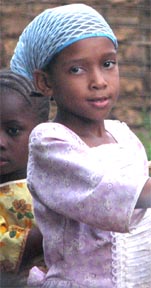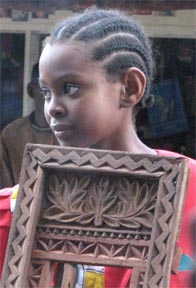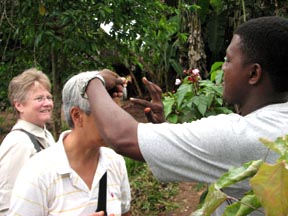 |
||||||||
| Day 21 — November 5, 2006 — Zanzibar Spice Tour & East Coast
After breakfast we watched fishermen casting their net as a storm approached. We spent most of the morning waiting for the heavy rain to ease up before braving a trip to the shops. Of course, we were hassled by the many entrepreneurs which only encouraged us to keep our trip short. After enjoying soup with a view we were off to the country. Our first stop was Marhubi Palace, built in 1880 by Sayyid Barghash for his harem and included over 50 hectares of gardens. It is surrounded by an extensive stone wall enclosure. The mango trees were imported by the Sultan from India. Although the palace was burnt down in 1890, the bath complex still stands which includes domed baths, pavilions, water storage tanks and an aqueduct. Nearby, boat-building was under way so we had to check that out. The history of Zanzibar would be incomplete without a spice tour. In the 19th century Zanzibar was the world's leading clove exporter. Cloves, nutmeg, cinnamon, pepper and many other spices were as important to the Sultans of Oman as the infamous slave trade. Our first spice stop was the Kidichi Persian Bath and Spice Farm — an interesting contrast. A detailed description was given about a variety of spices and their uses in cooking and cosmetics. But really it was just fun. The Kidichi baths were built in 1850 by Sultan Said, for his Persion wife Sherehezade. The baths are the only ones of their kind on the island, where visitors can see the Persian detailing on the inner walls. In strict following of the Muslim faith it is considered sacrilege to create images of anything living, including animals and people. The Kidichi bath ruins are unusual in that they exhibit interesting and obvious portrayals of birds and flowers in the bas-relief detailing of the inner walls. Built by Persian craftsmen, who were brought to Zanzibar by Sultan Said specifically for the purpose of building Sherehezade's baths, they were used by the princess to refresh herself after a journey in the country or after hunting. Sherehezade was apparently something of an avid hunter, a very unusual pastime for a woman in a Muslim community. Supposedly, these baths are the strongest evidence of Persian influence in all of East Africa. Leaving the baths we went up the road to check out some more spices with the opportunity to buy the product. Continuing on our way after stopping at a roadside wood carving shop with everything from doors to assorted small boxes we arrived at the east coast for our day and a half opportunity to lie in the sun. It was not something I was looking forward to. . |
||||||||
 |
 |
|||||||
 |
||||||||
 |
||||||||